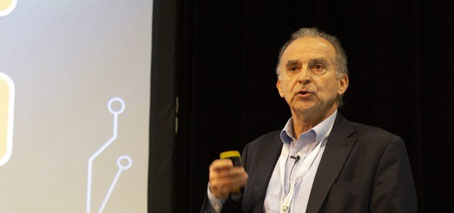
The electronics industry has led the development of new materials to support the scaling of silicon device technology to meet the ever-demanding Moore’s law [i] over the last 70 years. Silicon dioxide is a prime example of such scaling from a thickness of several hundred nanometers to about 2 nm at the end of the 1990’s. At that time nitrogen came to the rescue to enable scaling of SiO2 down to about 1.1 nm equivalent silicon dioxide thickness (EOT). High-k gate dielectrics and metal gates in the place of polysilicon gates were then developed and introduced to decrease the leakage and EOT even further. This is just an example of the many materials that have been developed and introduced over the years in the silicon flow, together with new transistor structures.
About 15 years ago, the Semiconductor Industry Association (SIA) together with the US President’s Council of Advisors on Science and Technology selected beyond CMOS devices as a grand challenge for the US semiconductor industry to address. The industry with the help of the Semiconductor Research Corporation (SRC) and US government funding agencies developed a program to address this challenge. As a result, the industry led the effort by providing funds to various universities to perform research to address this major grand challenge. The industry was able to engage university condensed matter physicists, chemists, materials scientists, and electrical engineers to discover, invent, study new effects, devices and materials to help address the beyond CMOS challenge. Since then, now more than a decade, new materials have been developed, new devices introduced and studied extensively, a new generation of scientists and engineers has been educated in the area of nanotechnology and nanoelectronics. In the meantime, the industry has continued to scale transistors but there is no significant breakthrough yet for beyond CMOS devices. The hope is that as the new generation of scientists and engineers populate companies and learn the companies specific product requirements more in depth, new materials and devices will be developed to meet future product roadmaps. One of the key lessons learned at least in the US is that it is highly beneficial for universities to work with scientists and engineers in industry to ensure that there is a good understanding of the overall basic device requirements.
In this presentation, I will discuss the various approaches that have been used in the interaction of industry with universities and how one might improve this interaction for the benefit of pre-competitive research.
[i] G. E. Moore, ‘‘Cramming more components onto integrated circuits,’’ Electronics, vol. 38, no. 8, pp. 114–117, 1965.
About the speaker
Luigi Colombo managed Texas Instruments (TI)’s external research and development activities including developing new device flows for ‘beyond CMOS’ devices.
He was responsible for research and development of new materials and devices for analog and logic applications at Texas Instruments (TI), where he was elected to the level of a TI Fellow in the External Development and Manufacturing group in 2011 for contributions to infrared detectors and high-dielectric constant materials.
He is currently an Adjunct Professor in the Department of Materials Science & Engineering at the University of Texas, Dallas.

